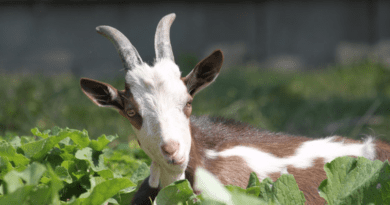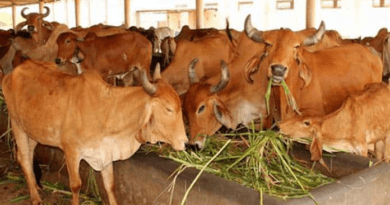Advantages of Small Ruminants Over Other Ruminants in the Supply of Meat
In this article, we will be discussing about sheep and goats otherwise referred to as small ruminants. Since most of the features, reproductive patterns, and management practices of sheep and goats are similar, we shall be studying them together where there are differences that need to be mentioned particularly, your attention will be drawn to such areas.
Small ruminants (sheep and goats) are a major source of livelihood in many parts of the world. Unlike cattle, they are owned even by poorer sectors of the community, attempts to increase the productivity of small ruminants is an important route to improving the standard of living of the rural poor and landless peasants.
Origin and History of Domestication
1. The sheep
All domesticated sheep are included in the genus Ovis Aries. There are 4 major species of wild sheep. These are:
1. Moufflon (O musimon) is mostly found in Europe and Western Asia.
2. Urial (O orientalis) found around Afghanistan to Western Asia.
3. Argan (O Ammon) found around central Asia.
4. Bighorn (O Canadensin) is found in Northern Asia and North America.
It is believed that the first 3 wild species have contributed to the makeup of the present-day sheep. Sheep and goats invade the first ruminants to be domesticated between 10,000 and 6000 BC. About one-fifth of the world’s sheep are found in the tropics. The sheep population has increased by about 13% during the last decade. Nigeria has about 22 million sheep.
2. The Goat
The domestic goat belongs to the genus Copra. This includes 3 species:
1. The bezoar (C aegagrus aegagrus).
2. The ibex (C aegagrus ibex).
3. The marcher (C aegagrus falconer).
The domestication of goats is said to have occurred in the mountainous area of Western Asia around 9,000 – 11000 years ago. The goat is possibly the earlier domesticated animal after the dog.
The bezoar goat is considered to be the major ancestor of this present-day goat. Goats represent about 15% of the world’s domesticated ruminants population. They perform best in the drier tropics and on lighter sandy soils. In Africa, the highest goat population is found in East Africa, Morocco, and Northern Nigeria.
Read Also Best Feeds for Young and Adult Ruminant Animals
Advantages of small ruminants over other ruminants in the supply of meat
In comparison to the world average of 6% Nigerian small ruminants contribute about 33% to the nation’s meat supply.
1. High reproductive rate
Small ruminants have a high fertility rate and high prolificacy ranging from 120 -135%. Twining rate is generally high in goats up to 55 -60% while that of sheep is about 20 – 22% Estrus cycle and estrus period are short about 18 days.
The estrus period ranges from 24 – 48 hours up to 72 hours. These are generally shorter in yearlings. Estrus occurs all year round in the tropics. The kidding/lambing interval is about 8 months while generation. The interval is about 2 years. In cattle calving interval is 2 years while the generation interval is about 4 years.
2. Less food needed
Because sheep and goats are ruminants they eat low-quality food, particularly fibrous vegetation which cannot be eaten by humans and nonruminant animals such as poultry and pigs.
3. Products in manageable quantities
1. The finished product from sheep and goats provides less storage problems hence they are suitable for rural communities with low levels of technology.
2. The meat and milk produced from small ruminants can be consumed within a day the problem of cold rooms for storage is therefore eliminated.
4. Less risk of total loss to arable farmers
In Sahelian countries, drought has demonstrated the greater resistance of sheep and goats over cattle. Small ruminants have survived such conditions and have been able to make up for the meat shortage caused by cattle losses. To the traditional arable farmer, small ruminants offer the security of continued food supply during periods of crop failure.
5. Low initial cost
The raising of small ruminants is less capital-intensive. While up to 70% of production cost in the monogastric go to feed the small ruminants can be completely raised on browse, pasture, and agricultural waste products.
The cost of sheep is much less than the cost of a cow and a smallholder may be able to afford to have one or two ewes but not a cow.
6. No Cultural Barriers
There are almost no cultural barriers against keeping sheep and goats or eating the meat. In contrast, Muslims and Jews do not keep pigs nor eat pork and Hindus do not slaughter cattle. Poor people as well as rich people own sheep and goats whereas it is usually only the rich who own.
Read Also Factors to Consider when Purchasing Ruminant Animals
Classification of Sheep and Goats

Several methods of classification of sheep and goats have been advocated based on origin, utility, body size, ear shape, and ear length and function. Each of these has its special attributes and limitations.
Based on body size using height at withers as the criterion, there are, 3 categories of sheep in Nigeria:
1. Large-legged long-tailed breeds.
2. Medium size breeds
3. Short-legged short-tailed breed.
| Classification weight(kg) | height at (cm) withers | weight (kg) | Life |
| Large breeds | > 65 | 30 – 65 | |
| Medium breeds | 50 – 65 | 19 – 37 | |
| Small or dwarf breeds | < 50 | 18 – 25 | |
The Major Breeds of Sheep
The 4 major breeds of sheep in Nigeria fall into these 3 groups. Large-legged long-tailed breed. This group contains two breeds. The first is:-
1. Balami
This breed of sheep has also been called the Bororo various times because it is associated with the people of the Borno tribe. Balami is the dominant sheep breed the features.
It is big predominantly white with a convex facial profile. The ears are large and droopy, the tail is thin and long. Males have horns while horns are absent in females. Matured males have dewlap Balami is a fast-growing animal with a good potential for milk production. (About 3-5 kg) for singles, 2.5 -3.5kg for twins).
A weaning weight of 18kg is possible at 12 weeks of age. Yearling weight is 35-45kg for ewes and 45 -60kg for rams. Its ability to survive under arid conditions is a character peculiar to this breed and can be exploited in the utilization of nonarable lands.
2. Uda (Ouda)
Also called the Fulani or Bali-Bali. This breed is found throughout the Sahel and savanna zones of tropical Africa. The cost color is black or brown in front and white behind. They are large with matured males measuring up to 84cm in height at withers.
The breed is long-legged, thin, and long-tailed with moderately long, floppy ears males carry horns which could be large emerging sideways and slightly backward with Taoist mature rams weighing 55kg while females weigh 45kg.
This breed thrives best in hot dry environments it is particularly adapted to extensive grazing and is known for its trekking ability. Uda suffers poor survival outside the domain of medium-sized breeds.
3. Yankasa
This is perhaps the most numerous and widely distributed Nigerian breed of sheep. Yankasa is found throughout the Sahel, Sudan, and Guinea savanna zones. It is intermediate between large long-legged uda and Balami and short-legged West Africa Dwarf.
The breed has a typical white cost color with black patches around the eyes ears and muzzle and sometimes the feet. Ewes may have passed around the neck. Males have curved horns. Matured rams weigh 30 – 45kg and ewes 25 – 30kg.
Short-legged short-tailed breed
1. West African Dwarf sheep
Also called Fouta Djallon, the forest shows, Djallonke. This breed is found in the whole area of the forest belt. Color ranges from all white, all black, or brown to spotted black or brown on a white coat. The breed strives well in its area of occurrence which is known to be infected with tsetse fly hence the assertion that the breed is trymo-tolerant.
Matured females have tassels while matured males have spiral or crescent-shaped horns and a heavy mane. The breed has a slow growth rate, maturity and cessation of growth are between 18 – 24 months. The breed is highly prolific and the incidence of twining is high (55– 58%) matured females weigh 20 -25kg and mature males weigh 20 m- 30kg.
What has been described so far are the indigenous breeds of sheep found in Nigeria. There are very many breeds of sheep in the tropics and elsewhere. In the area, sheep have shown a remarkable adaptation to the local environment.
In the humid parts of West Africa where the Tse-tse fly is common sheep have developed tolerance to trypanosomiasis through the evolvement of the West Africa Dwarf sheep. In the Middle East and eastern Africa, sheep have fat tails which are food reserves to lose through the dry season.
There has also been some selection by man for the kinds of animals he prefers. This has been extensively carried out in developed countries there are therefore specialized breeds for milk or wool production. In general, however, there has been little deliberate selection and there is often much variation within local breeds concerning both appearance and productivity.
Sheep and Goats originated from Asia and were the first ruminants to be domesticated. Being small when compared to cattle, small ruminants occupy a unique position in the livestock sector. For classification, several criteria have been proposed each with its limitations. Body size and height at withers have been used to classify sheep breeds in this article.
Read Also Sheep 101: Wool Production Complete Guide









